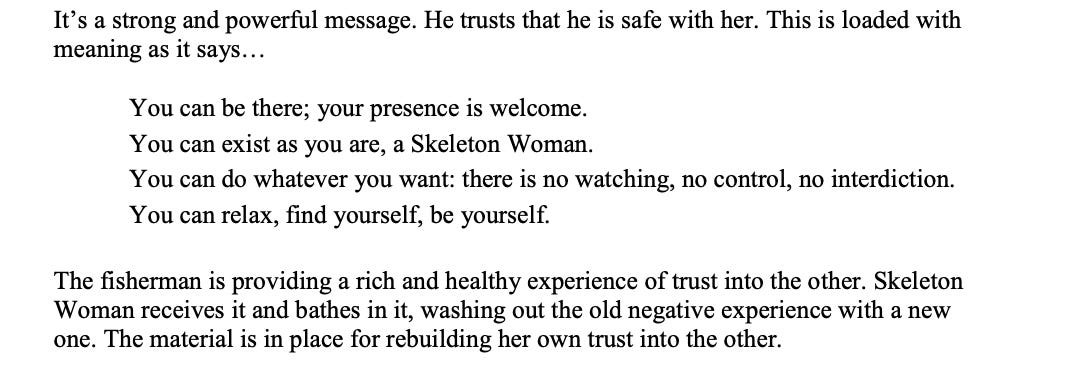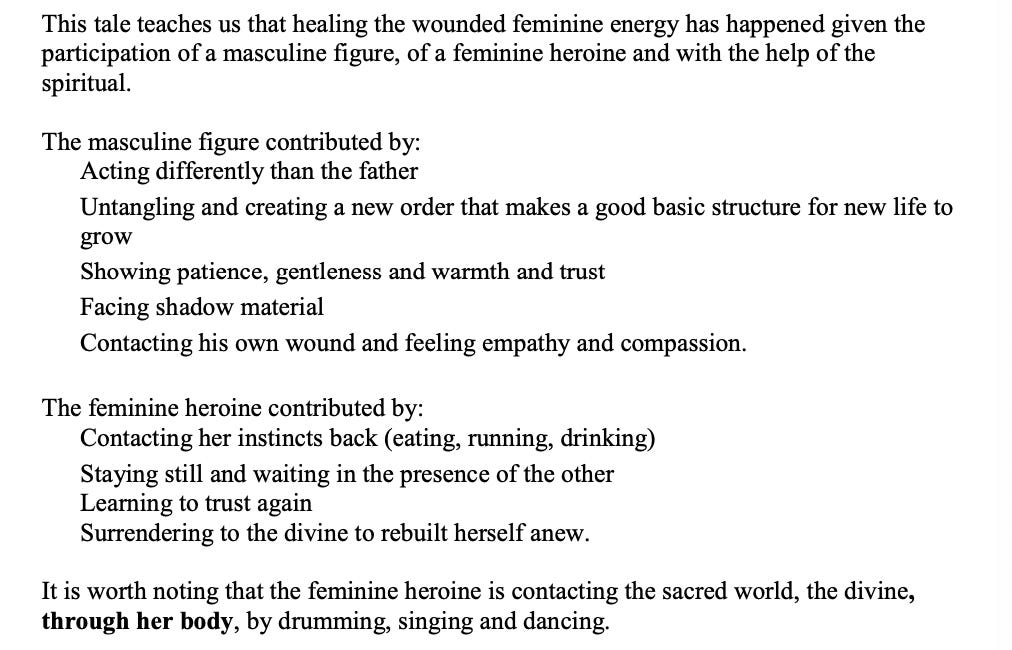[3.0] Skeleton Woman ❤️🩹💀🎣
a reading of the Inuit tale & lessons on the counter-intuitive role of Death in Romance
In a time where the post-capitalist affair of Valentine’s Day is held up as the apex standard for romance, today I wanted to share a story that completely changed my expectations of and orientation to romantic love.
Can Love be Radical?
Growing up, you likely heard folktales and mythology that centered on morality: good v. bad, the hero’s journey, how to be a dutiful, ethical, and virtuous person. Similarly fairytale romances were sweeping fantasies marked with heroic rescues, love at first sight, star-crossed lovers fighting to be together against all odds. The Romantics really set us up to fail, because the reality of romantic love in modern times has often fallen far short of our expectations. From the History of Love,
The Dream of Love Survives, but Constantly Disappoints.
We could also take the extra cynical view of Valentine’s Day - that it’s a product of politcal and capitalist manufacturing. Romantic love is the fundamental building block of the nuclear family, a microstructure of capitalism and patriarchy. We are socially conditioned to seek out heternormative relationships and perform within rigid gender roles. We chase romance and settle for the groundhog day reality of domesticity.
Valentine’s Day, along with our notions of romantic love, are simply tools of a capitalist machine to exploit us for all we’ve got. We’re sentimental fools for falling for it.
Yes, we could choose to believe this narrative... But our wild women ancestors teach us something different- that romantic love can be a place of profound connection, transformation, and healing.
Through the collective trauma of colonization, we’ve lost many of the stories that centered the wisdom of the Wild Woman. So Dr. Clarissa Pinkola Estes has done us a great service with Women Who Run with the Wolves, where she shares a collection of stories along with wise compassionate and very detailed psychospiritual analysis on the lessons we can learn from them. This book is an epic handbook of how we can tap into our passion, sensitivity, creatitiy, and the timeless wisdom of our intuition.
The Inuit tale of the Skeleton Woman shares many lessons on the interplay between the role of the divine masculine and feminine in romantic love and the necessary stages in its development. We need stories like this that teach us how to heal our wounds of trauma, how to approach those of our partner’s, signs to look for in building trust, and how to navigate relationships with care. As you’ll see, this story is unlike any romance you’ve ever heard.
The Skeleton Woman: The Tale
Skeleton Woman is an Inuit tale and can be found in Chapter 5 Hunting: When the Heart is a Lonely Hunter. In this tale, death plays a central role in the development of the romance.
“A part of every woman and every man resists knowing that in all love relationships Death must have her share… Because love always causes a descent into the Death nature, we can see why it takes abundant self-power and soulfulness to make that commitment. When one commits to love, one also commits to the revivification of the essence of Skeleton Woman and all her teachings” (Estes 148)
The Seven Tasks
Estes writes that this tale is most valuable when understood as a series of seven tasks that teach one soul to love another deeply and well.
Discovering another person as a kind of spiritual treasure, even though one may not at first realize what one has found
The Chase and the hiding, a time of hopes and fears for both
Then comes the untangling and understanding of the Life/Death/Life aspects of the relationship and the development of compassion for the task
Next come the relaxing into trust, the ability to rest in the presence and goodwill of the other.
A time of sharing both future dreams and past sadness, these being the beginning of healing archaic wounds with regards to love
Then the use of the heart to sing up new life
Finally the intermingling of body and soul1
The Healing Journey
This story is a story of love, but it’s also a story of healing for the feminine.2 After experiencing trauma, abuse, and symbollically experiencing loss of her self, Skeleton Woman is inert. She is not using he connection to the Life-Death-Life force to complete cycles of birthings and endings, grievings and celebrations. The healing journey for the Skeleton Woman then begins rather abruptly and in a greusome manner, accidentally caught in the hook of the fisherman and dragged upwards through the sea. The beginning of her healing journey symbolizes the disorienting experience of confronting our shadow, meeting that which is ugly, our discarded parts. Despite her best efforts to stay in solitude (as she did not go out looking to be caught in the fishermann’s hook), love catches the Skeleton Woman off guard.
The fisherman on the other hand had gone out looking to catch a fish - he just got way more than he bargained for. The fisherman has to learn to embrace Lady Death and all her teachings on the cycle of life. When lovers are able to embrace the nature of life-death-life, feel it as a continuum and not something to run away from, it is only then that they can uphold a relationship that lasts a lifetime - when they invite Skeleton Woman to join.
Estes argues that each of these steps are required in the natural progression of a romantic relationship. She says it is a matter of archetypal blueprint, that in any love there is supposed to be a chase between the fisherman and Death Woman is naturally supposed to follow him along right into his safe haven. We freak out when things become tangled and difficult in dating, but Estes assures us that this is a necessary step in order for true love to be born.
So too is the entering of Skeleton Woman, or death, into a relationship.
The Untangling
There’s a point where the sheen wears off and you see exactly who is sitting in front of you, warts and all. Do you turn away or turn toward? The fisherman eventually turns towards the Skeleton Woman with compassion, demonstrating acts of positive mothering. He looks at her with kindness. He takes time with the task of untangling without losing patience. Singing softly, he slowly puts her back together, counteracting her previous traumatic experience with her father.
In fairytales, we’re used to hearing epic stories of true love’s kiss, miraculous bouts of healing, fighting to be together. But here we see it is in the quite ordinary tasks of listening, holding space, and witnessing that healing and later love can occur. I like Cloutier’s point too that the fisherman has the positive mothering aspect along with the masculine aspect of bringing order to chaos, an analytical mind to the untangling of the Skeleton Woman. He is able to stay grounded, strong, and face that which is not beautiful.
At this point, the Skeleton Woman dares not say a word as she doesn’t want to be rejected and abused again. How painfully and hilariously accurate. How often have I after inadvertently undergoing the nauseating experience of being vulnerable and perceived, have I found myself also frozen with the fear of what would come next?
The story shares wisdom on how the Skeleton Woman must learn to trust. She has to sit still and wait. Even when every instinct in her body is telling her to jingle jangle out of the hut and back into the safety of the deep dark ocean cave, she must wait and observe, learn to discern between negative and positive masculine actions. She learns to look for the small simple actions that demonstrate a healthy masculine - warmth, generosity, tenderness, care, honesty, clarity.
Building Trust & Compassion
When the fisherman falls asleep next to the Skeleton Woman, he sends her a message, “I trust you.”

Again this story demonstrates that romance is not in grand romantic gestures, but in the smallest of exchanges in building trust. The fisherman relaxes so deeply that he falls asleep and he sheds a tear of compassion as he dreams. The tenderness he feels for the Skeleton Woman, stirs up his own memories of hidden pain. It shows the Skeleton Woman that she is not alone, that he too is carrying a painful past.
This tear, the fisherman’s vulnerability, draws The Skeleton Woman near. Thirsty for connection and compassion, she drinks the tear and it revives her, bringing life back into her, helping her regain her connection to her emotional and intuitive self.
In this sleep of trust, they find together a state of wise innocence. In sleep, we find this state of sweetness and even wonder. We shed cynicism and stress. Through tears and this sleep of trust, they’re learning to see life through innocent eyes.
“La inocente is the name often given to a curandera healer, one who heals others of injury or harm. To be an innocent means to be able to see clearly what is the matter and to mend it.” (Estes p. 161)
With Love, Creating Anew
She begins to create anew with the heart of the fisherman, his love. The Skeleton Woman plays the drum with the fisherman’s heart, sings out loud for flesh, and transforms through ritual.
Through the ritual she is conducting her own healing. It’s like the tear was the catalyst, but she must complete the cycle of transformation herself. It is only when she’s integrated her different parts, and learned to befriend her demons, that she is able to have an intimate relationship with the fisherman. Through the ritual she’s reconnected to her sensual intuitive nature. The Skeleton Woman is revived into a lush woman, singing and dancing. She symbolizes how when brought to life through love, the feminine returns the gift to the masculine by becoming ally, partner, teacher, and lover.
The fisherman too is revived and inspired through laying with the Skeleton Woman. As she uses his heart as a drum, the fisherman is filled with the magical vibrations of her song and feels more alive than ever.
By merging song with flesh, through facing their fears, through surrendering to the natural cycle of Life-Death-Life, the Fisherman and Skeleton Woman learn how love works - with each partner transforming the other.
The Lessons from Skeleton Woman

For those who relate to the Fisherman in the story, consider how you integrate your Masculine with your Animus, the aspect of the Feminine in your Psyche. How do you integrate strength with grace? How are you facing and integrating your own shadow? Have you come to learn to embrace Death and her wisdom in life and love?
For those who relate to the Skeleton Woman, how is the strength of your connection to your intuition? Does your intution guide your natural rhythms of self-care and creation? How are you learning to trust in your relationships? How do you bring the divine to life in your body and environment?
happy valentine’s day radical baddies 😈💖 may your love change you! may your love be radical, transformative, & healing 💕🌀🦋✨
Clarissa Pinkola Estes, Women Who Run with the Wolves (p. 145)
Referencing Francoise A. Cloutier’s lecture The Skeleton Woman: Healing through Relating














